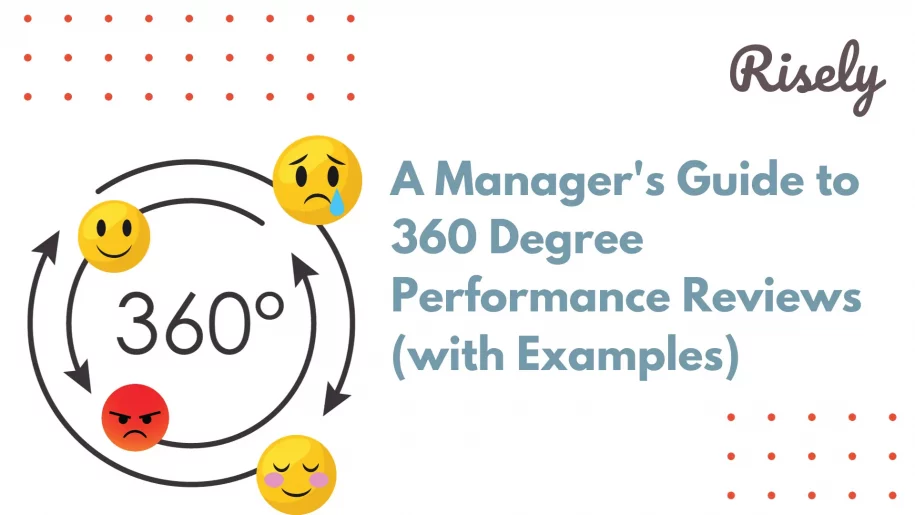A Manager’s Guide to 360-Degree Performance Reviews (with Examples)
As a manager, providing comprehensive feedback to employees can be challenging. Traditional performance reviews have limitations and may not always reflect an employee’s strengths and weaknesses. This is where 360-degree performance reviews come in. In this blog, we will explore what 360-degree performance reviews are, why they are essential for HR managers, and how to prepare for one. We will also examine the pros and cons of 360-degree assessments and provide examples of compelling reviews.- A Manager’s Guide to 360-Degree Performance Reviews (with Examples)
- Understanding 360-degree performance reviews
- What are the benefits of 360-degree performance appraisals for HR managers?
- How to prepare for a 360-degree performance review?
- How to do a 360-Degree Performance Review?
- Sample Questions for 360-Degree Performance Review
- Free 360-Degree Performance Review Template
- Overcoming common challenges in 360-degree performance reviews
- Measuring the success of your 360-degree performance review process
- Conclusion
- Other Related Blogs
Understanding 360-degree performance reviews
360-degree performance reviews provide valuable insights into employee performance by gathering feedback from multiple perspectives. This comprehensive approach allows managers to assess the competencies and skills from various stakeholders, including direct reports, peers, and even customers. By promoting transparency and fostering a culture of feedback, these reviews create opportunities for improvement and personal development. They also offer a more holistic view of employee performance than traditional reviews. The candid feedback received through 360-degree assessments can significantly contribute to career development and ultimately lead to great success for both the employee and the organization. Read more: Performance Management 101 for Leaders: 5 Steps to Ace the ProcessExamples of effective 360-degree reviews
Here are three examples of effective 360-degree review processes: Leadership Development 360-Degree Review:- This process is commonly used for leadership development programs. It involves gathering feedback from an individual’s supervisor, peers, direct reports, and sometimes even external stakeholders such as clients or customers.
- The evaluation criteria may include leadership competencies, communication skills, decision-making abilities, and teamwork.
- The feedback is typically used to create personalized leadership development plans, including coaching and training, to enhance leadership effectiveness.
- In a team-focused 360-degree review, team members evaluate each other’s contributions and teamwork. This process helps improve collaboration and team dynamics.
- Criteria may include communication within the team, problem-solving abilities, task allocation, and overall team effectiveness.
- The feedback is used to identify areas where the team can improve its performance, leading to more efficient and productive teamwork.
- This type of 360-degree review focuses on the growth and development of individual employees. Feedback is collected from supervisors, peers, and sometimes subordinates.
- The criteria may include job-specific skills, interpersonal skills, adaptability, and overall job performance.
- The feedback aids in creating personalized development plans to address specific skill gaps and encourage career progression.
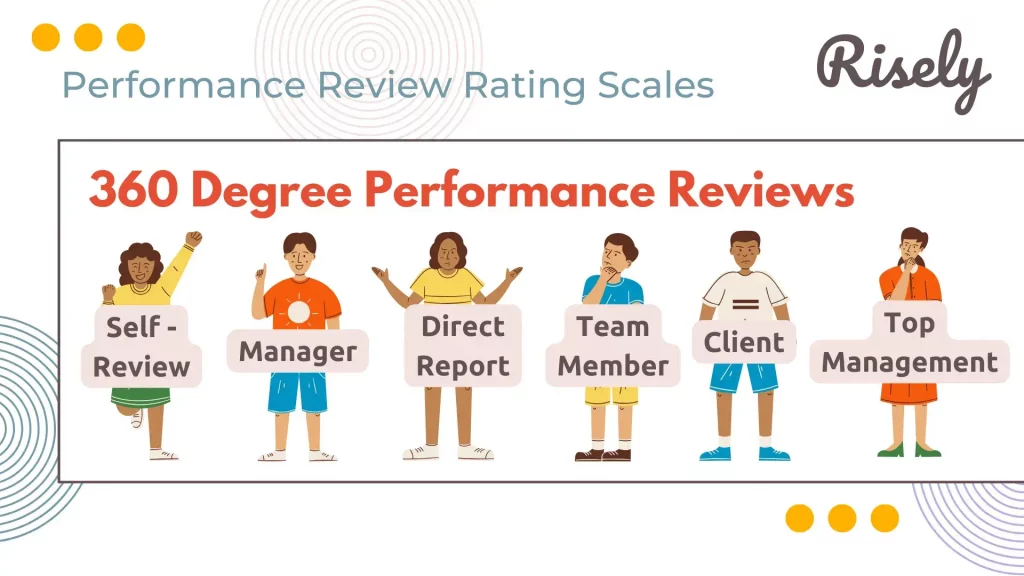
What are the benefits of 360-degree performance appraisals for HR managers?
360-degree performance reviews are essential for HR managers as they enable them to gather feedback from multiple sources, providing a well-rounded view of an employee’s performance. They help identify training and development needs, facilitate fair and unbiased performance evaluations, and support the alignment of individual and organizational goals. Another helpful feature of 360-degree reviews is that they help beat the various biases in performance reviews by distributing the scope of assessment across stakeholders. 360-degree reviews benefit professionals in leadership and management roles, especially as they can overcome the shortage of frank feedback and development conversations. The exercise can help them become more accountable and motivated to work with their team. By receiving feedback from direct reports, peers, and co-workers, HR managers can gain valuable insights and constructive criticism to create employee development plans. Implementing 360-degree reviews can lead to great success in employee performance reviews and foster a culture of candid feedback in the workforce. It helps initiate action even in those relationships where the potential for conflict and limited openness remain consistent challenges.Pros and cons of 360 degree performance reviews
Pros
- Holistic Performance View: Collects feedback from diverse sources (direct reports, peers, self, and supervisors) to comprehensively understand employee performance, strengths, and weaknesses.
- Enhances Teamwork and Collaboration: Cultivates a culture of open and candid feedback among coworkers, which improves communication and working relationships.
Cons
- Resource and Time-Intensive: The feedback collection process can be time-consuming, and it may be perceived as a resource burden by employees and administrators.
- Potential for Conflicting Feedback: Conflicting feedback from various sources can be challenging to reconcile. Resolving differences in feedback may require additional effort that could lead to confusion or frustration among participants.
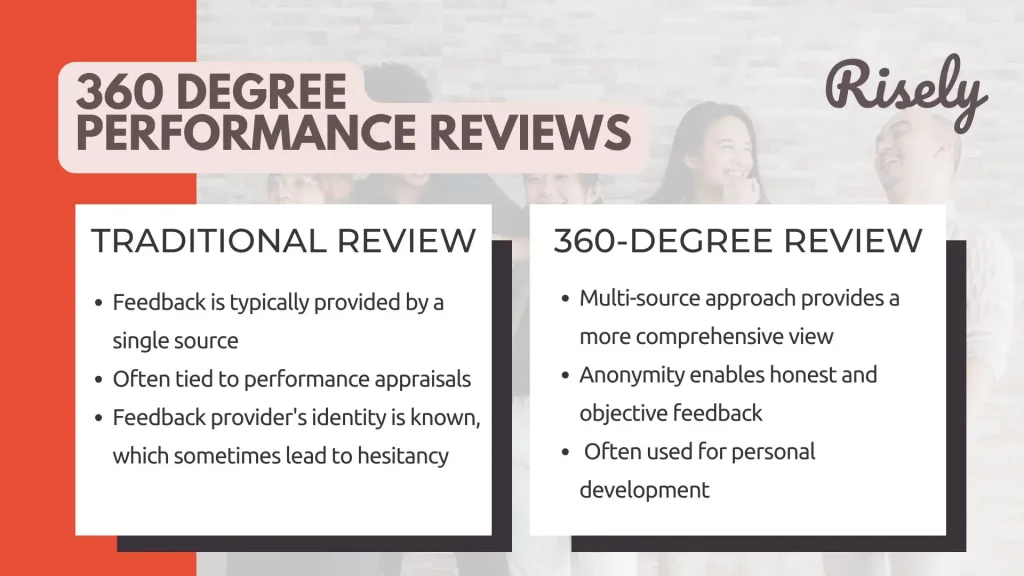
How to prepare for a 360-degree performance review?
Conducting an effective 360-degree performance review exercise can appear like a challenge. But worry not! There are a few easy steps to get this right! At the onset, it is crucial to communicate the purpose and process of the review to all stakeholders involved. A few ways to prepare your team for a 360-degree review are:- Provide clear instructions on providing constructive feedback to ensure helpful feedback is received.
- Prepare employees for receiving input from multiple sources, emphasizing the benefits of this approach.
- Set expectations regarding confidentiality and anonymity to create a safe environment for open and honest feedback.
- Provide resources such as templates and share examples and case studies to explain the process of 360-degree performance reviews.
The role of technology in conducting 360-degree performance reviews
Technology plays a crucial role in the process of conducting 360-degree performance reviews. By streamlining and automating the review process, technology eliminates the need for manual paperwork and reduces administrative burden. Online platforms provide a convenient and efficient way to collect and analyze feedback from various sources, including direct reports, peers, and managers. These platforms also ensure the secure sharing of feedback reports, allowing for easy access by the relevant parties. Real-time data and analytics provided by technology enable organizations to evaluate employee performance objectively. Technology supports ongoing performance management and facilitates continuous feedback, aiding employee development and career growth.How does this work?
You can explore Risely’s range of assessments for critical leadership skills today to assess your skills and anonymously collect feedback from your team. Here’s how it goes:- Launch a self-assessment and get your score
- Request your team members to share feedback on your skills
- Generate a combined report to catch insights on strengths, weaknesses, and gaps that miss your eye!
Other Interesting Reads
How to do a 360-Degree Performance Review?
Understanding the 30-Degree Performance Review Process
The 360-degree interview process involves several key steps to gather feedback from various perspectives and comprehensively assess an individual’s performance. Here are five essential steps in this process:- Identify Key Stakeholders: Determine the individuals who will provide feedback, typically including supervisors, peers, and direct reports. Define the scope of the review, specifying who will participate and the purpose of the evaluation.
- Develop Evaluation Criteria: Create a set of standardized criteria for your team to assess the individual’s performance. These criteria may encompass communication skills, teamwork, leadership abilities, and overall job performance.
- Collect Feedback: In the next step, you need to collect feedback through a method suitable for your team. You can utilize anonymous surveys or interviews to gather input from the identified stakeholders. Ensure that the feedback process is confidential to encourage candid responses.
- Compile and Analyze Feedback: Collect all feedback and data from surveys or interviews. Analyze the responses to identify patterns, common themes, and areas of consensus or divergence.
- Provide Feedback and Create Development Plans: Share the feedback with the individual being evaluated in a constructive and supportive manner. Finally, managers can collaboratively develop an improvement plan based on the identified strengths and areas for growth, including clear goals and actions for development and growth, incorporating the insights from the 360-degree review.
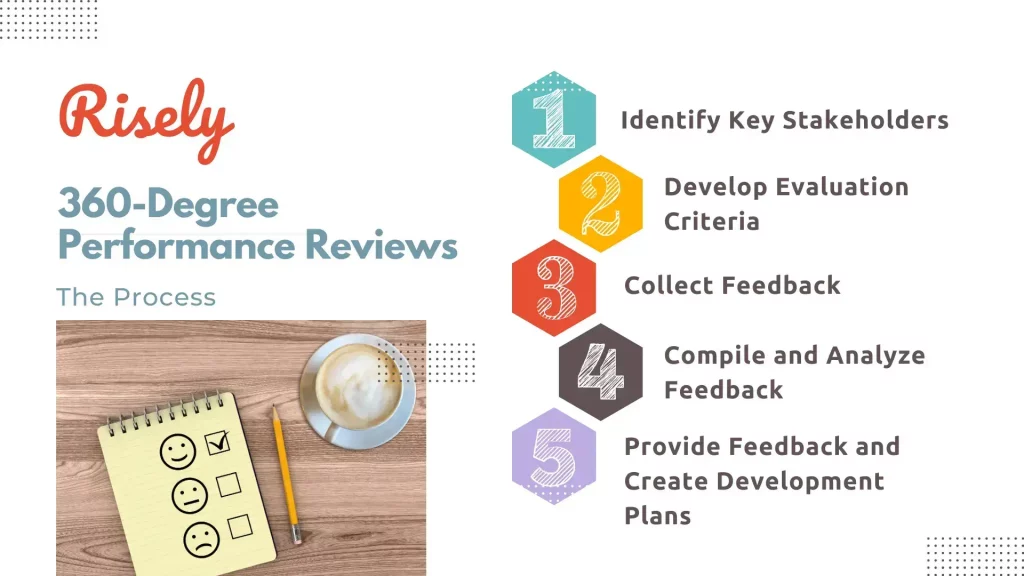
Sample Questions for 360-Degree Performance Review
Sample Questions for360-degree performance reviews for supervisors:- How effectively does the individual communicate goals and expectations to their team?
- What are the individual’s key strengths as a leader?
- In what areas do you think the individual could improve as a supervisor?
- How well does the individual support and provide guidance to team members?
- How does the individual handle conflicts or challenges within the team?
- How would you rate the individual’s ability to make decisions and solve problems?
- Does the individual effectively delegate tasks and responsibilities?
- How does the individual contribute to the overall success of the team or organization?
- How would you describe the individual’s communication skills when collaborating with peers?
- What strengths does the individual bring to team projects and interactions?
- Are there areas where the individual could enhance their collaboration with colleagues?
- How well does the individual provide support and assistance to fellow team members?
- How does the individual handle disagreements or conflicts with peers?
- Does the individual actively contribute to the success of group projects?
- How would you rate the individual’s ability to adapt to changing circumstances?
- What suggestions do you have for the individual to improve their peer relationships?
- How effectively does the individual communicate job expectations and provide feedback?
- What are the individual’s strengths as a manager or supervisor?
- Are there areas where the individual could enhance their leadership and support?
- How well does the individual foster a positive and inclusive work environment?
- How does the individual handle employee concerns or conflicts?
- Does the individual encourage professional development and growth among team members?
- How would you rate the individual’s ability to provide coaching and guidance?
- What recommendations do you have for the individual to improve their leadership style?
Free 360-Degree Performance Review Template
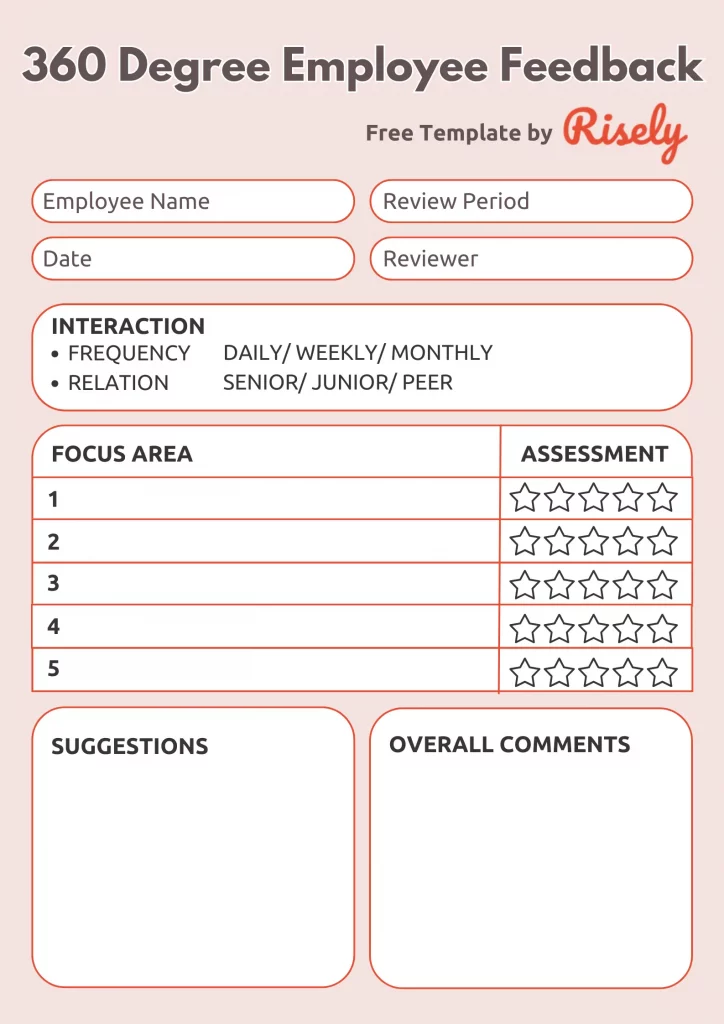
Best practices for effective feedback from a 360-degree review
- To ensure personal development:
- Provide actionable feedback.
- Foster honesty and transparency in the feedback process.
- Streamline the review process by using performance management software.
- Incorporate feedback from peers and subordinates for multiple perspectives.
- Instead of solely highlighting strengths, focus on areas of improvement
Overcoming common challenges in 360-degree performance reviews
To successfully implement 360-degree performance reviews, addressing resistance to change by involving employees in decision-making and explaining the benefits is essential. In the next section of this blog, we will look into the common challenges in the 360-degree performance review process and identify solutions to tackle them.Resistance to change in the organization
Traditional performance reviews have taken hold of the management space for years. Hence, it’s not surprising to see that often, people are not open to changing the entire performance review process, especially when it appears to be a massive overhaul. It happens because of unfamiliarity and lack of trust in the new system. Hence, the way out lies in communicating the needs and benefits of the 360-degree performance review method. It is crucial to communicate the need for change and highlight the potential benefits for employees. Involving employees in the decision-making process can address their concerns, and support for the new system can be generated. Providing training and support to help employees adapt to the changes and understand the value of 360-degree feedback is essential. Recognizing and rewarding early adopters and success stories can inspire others to embrace the new review process. Continuously communicating the progress and positive outcomes of the 360-degree reviews helps to sustain momentum and overcome resistance to change.Ensuring confidentiality and anonymity in the review process
Involving everyone in the performance review process opens up as many cases of potential conflicts as there are people – but there’s a way out. Managers need to take steps to ensure employees’ concerns are handled effectively for a smooth performance review. Depending on the team’s needs, using a secure and anonymous feedback platform may be essential. This platform will protect the integrity and confidentiality of the review data by implementing strict access controls and regularly updating security measures. Communicating to all participants that their feedback will be confidential and anonymous helps build trust. Training managers and reviewers on confidentiality and anonymity further strengthen this trust.Dealing with unresponsive or uncooperative reviewers
Communicating expectations and deadlines to all participants ensures a smooth 360-degree performance review process. In case there are unresponsive reviewers, providing reminders and follow-ups can help emphasize the importance of their input. Additionally, offering support and resources can assist reviewers in overcoming any challenges they may face. Recognizing and rewarding timely and thorough completion of reviews can further incentivize participation. Finally, analyzing the data can help identify patterns or trends in unresponsiveness and address any underlying issues.Managing negative feedback from multiple sources
When managing negative feedback from multiple sources in a 360 performance review, it is essential to look for common themes or patterns in the feedback. Providing specific examples and suggestions for improvement can help the employee understand how to address the feedback effectively. Open communication and dialogue can also help clarify any concerns or misunderstandings. Additionally, offering coaching and mentoring can support the reviewee in overcoming challenges identified in the feedback. Emphasizing the importance of feedback as a tool for growth and development can motivate the reviewee to use it constructively.Measuring the success of your 360-degree performance review process
For managers to ensure the success of their 360-degree performance review process, it is crucial to define clear objectives and key performance indicators (KPIs) to measure its effectiveness. Collect participant feedback to assess their satisfaction and perceived effectiveness of the review process. Evaluate changes in employee performance and development based on the feedback received. Compare the results of the 360-degree reviews with other performance evaluation methods to identify areas of alignment and improvement. This analysis helps identify common themes or areas of concern that need to be addressed. Managers should conduct regular reviews and evaluations of the review process to identify areas that require improvement. Seeking input from stakeholders, such as managers and HR, can provide valuable insights and suggestions for enhancing the review process. The review process can be continuously improved by implementing changes based on feedback and constantly monitoring the impact of these changes.Conclusion
In conclusion, 360-degree performance reviews give HR managers a well-rounded perspective on employee performance and development. By incorporating feedback from multiple sources, these reviews offer a comprehensive view of an individual’s strengths, areas for improvement, and growth opportunities. Managers must prepare adequately for these reviews by setting clear expectations, selecting appropriate questions, and leveraging technology to streamline the process. Additionally, managers should focus on building trust and buy-in among employees, overcoming challenges, and handling difficult feedback with sensitivity and professionalism. By implementing and measuring the success of 360-degree performance reviews, organizations can enhance their performance management systems and foster a culture of continuous improvement.Ace performance reviews with strong feedback skills.
Master the art of constructive feedback by reviewing your skills with a free assessment now.
Other Related Blogs
How to build and retain high performing employees? | Laletha Nithiyanandan
How to build and retain high performing employees? | Laletha Nithiyanandan Are you really an HR if you have not spent hours chasing the ideal high performing employees for your…
How Can You Build A High Performing Culture? 7 Hacks
How Can You Build A High Performing Culture? 7 Hacks We have all heard of dream teams and tried to build them with varying levels of success and failure. Among…
10 Effective Manager Performance Goals to Drive Team Success
10 Effective Manager Performance Goals to Drive Team Success You’re sitting across from a manager in a performance review meeting. They seem unsure, disconnected from the company’s vision, and oblivious…
How to Build a High-Performing Team?
How to Build a High-Performing Team? Creating a high-performing team is a goal that every organization aspires to achieve. A high-performing team achieves superior results and can quickly adapt to…

